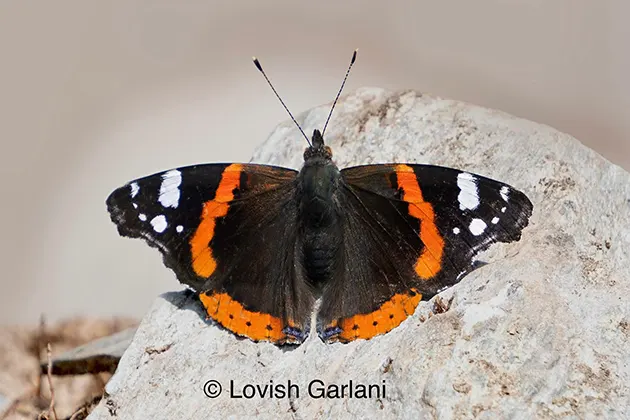[ Prem Chetry ]
BOMDILA/DHARAM-SHALA, 4 May: The European Red Admiral butterfly has been recorded for the first time in India- specifically in Dharamshala, Himachal Pradesh. This observation marks a new addition to the Indian butterfly fauna.
The European Red Admiral is a widely distributed species known for its active migration, but it hadnever before been reported from India. Lovish Garlani, who recorded and identified this rare butterfly species, said that he has been studying the butterflies of Himachal Pradesh since 2009. What began as a photography hobby eventually turned into a dedicated career in butterfly research.
Garlani currently serves as a technical consultant with the Himachal Pradesh Forest Department, contributing to various butterfly research projects. He played a key role in establishing the first butterfly museum in the Bhattiyat forest range under the Dalhousie Forest Division. In 2024, he authored the book Annotated Checklist of Butterflies of Himachal Pradesh, and has published research articles in several international journals.
Reflecting on the sighting, Garlani said, “Just a few days ago, I was discussing the recent rediscovery of this species in Pakistan with my friend Ackram Awan, a fellow butterfly researcher. We believed it would soon be spotted in India as well.”
He also had an in-depth discussion on the species with Bhattiyat Range Forest Officer Sanjeev Kumar.
“On 22 April, during an opportunistic survey around the Dharamshala region, while photographing the Circe butterfly, I came across a single specimen of the European Red Admiral among several Indian Red Admirals,” he added.
This sighting, at Thatharna Hilltop near Dharamshala, at an altitude of 2,500 metres, is the first confirmed record of the species in India. The addition brings the total number of butterfly species recorded in Himachal Pradesh to 440.
The European Red Admiral is distributed across North America – from Canada to Mexico – and is well-established in Central Asia. In South Asia, it was first reported in 1929 from Balochistan province, and in 2022, it was rediscovered in Pakistan’s Lower Chitral region after 93 years. Notably, there are no confirmed reports of the species from China, Mongolia, or Afghanistan. This record from Dharamshala confirms an eastward expansion of its distribution in the Eurasian region.
According to Garlani, the larvae of the European Red Admiral feed on stinging nettle, a plant that grows abundantly across the Western Himalayas. The availability of this host plant and favourable climatic conditions could explain the butterfly’s active migration into the region. However, it is difficult to determine whether this sighting represents an occasional migrant or the beginning of an established population in the Western Himalayas.
The European Red Admiral closely resembles its cousin, the Indian Red Admiral. However, it differs in having a darker, compact crimson-red discal band on the upper forewing, in contrast to the broader, paler scarlet-red band with irregular margins seen in the Indian species. Another distinguishing feature is a consistent spot in wing space 3 in the European species, which is invariably absent in the Indian counterpart.
Since the European Red Admiral shares the same habitat and host plants as the Indian Red Admiral and the Indian tortoiseshell, it will be interesting to observe how these native species interact with this newcomer. This sighting suggests that the European Red Admiral may be more widely distributed in India than previously thought – particularly in Jammu & Kashmir – and underscores the need for further surveys, especially in the Western Himalayas. Its potential range may extend along the Nepal border, and it is likely to be found in Uttarakhand with more exploration.
Meanwhile, Garlani noted that there is also a high possibility of the species appearing in the Northeast in the near future, due to the region’s suitable environmental conditions and host plant availability.



